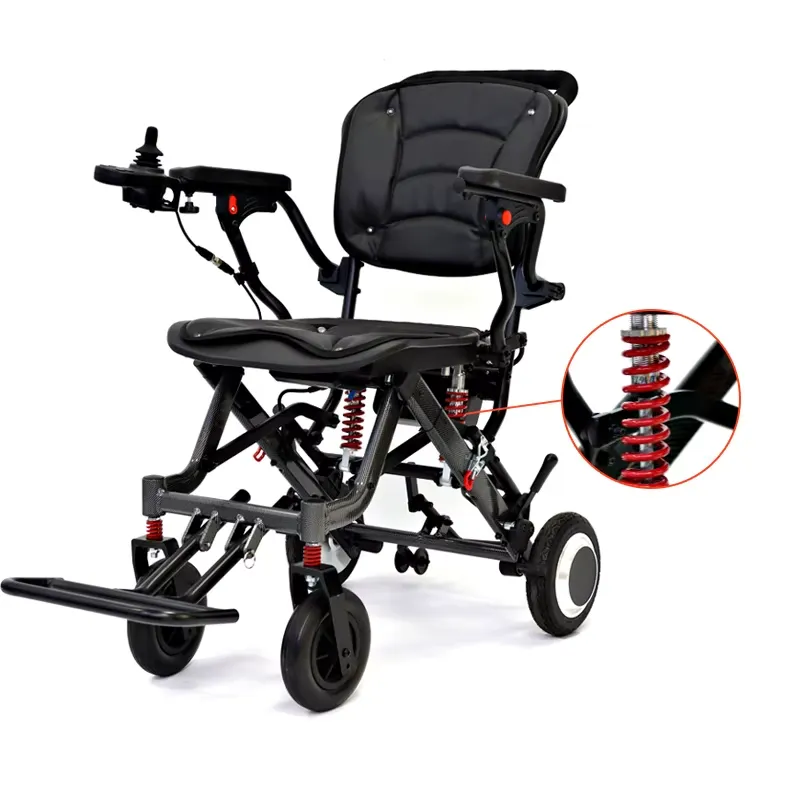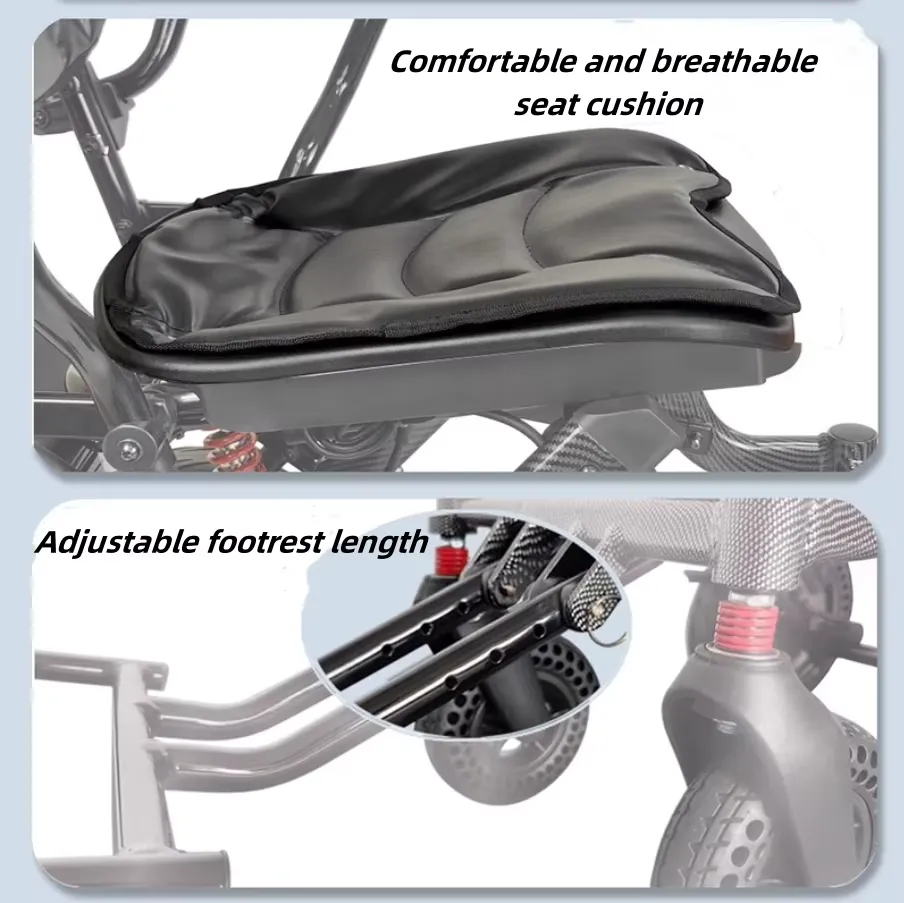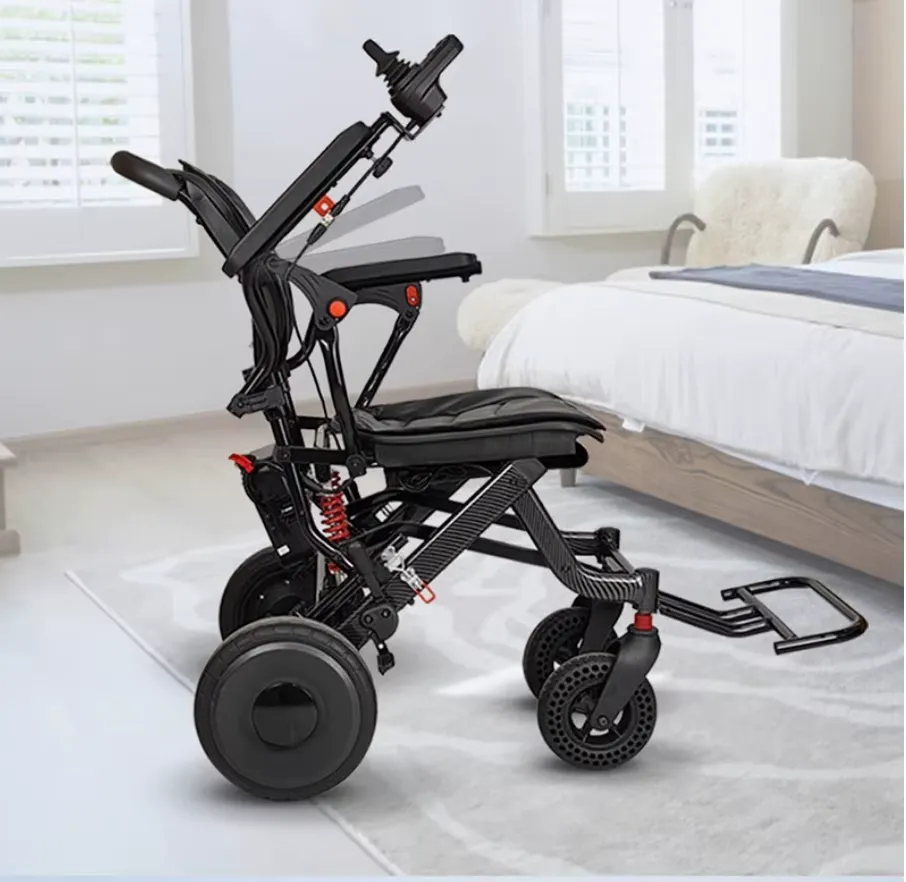For elderly individuals facing mobility challenges, maintaining independence and quality of life is paramount. Traditional manual wheelchairs often require significant upper body strength, while standard electric wheelchairs can be prohibitively heavy and cumbersome. The lightweight electric wheelchair represents an ideal solution for seniors, combining the independence of powered mobility with manageable weight and dimensions. This specialized mobility device enables elderly users to maintain active lifestyles, participate in social activities, and navigate their environments with confidence and dignity.

Understanding Lightweight Electric Wheelchairs for Elderly Users
Lightweight electric wheelchairs are specialized mobility devices engineered specifically to address the unique needs of elderly users. Unlike standard electric wheelchairs designed primarily for institutional or full-time use, these senior-friendly chairs feature reduced weight, simplified controls, and dimensions appropriate for home environments while maintaining essential powered mobility functions.
The Evolution of Senior Mobility Solutions
Mobility solutions for the elderly have undergone significant evolution over recent decades. Early powered options were often institutional-grade equipment—heavy, difficult to transport, and designed more for durability than user-friendliness. These limitations meant that many seniors delayed adopting powered mobility aids until absolutely necessary, often sacrificing independence and social engagement in the process.
The development of lightweight electric wheelchairs represents a significant advancement in geriatric mobility design. These chairs emerged from recognizing that elderly users have distinct needs: they often transition between walking and wheelchair use, require transportation in family vehicles, and need equipment that can be managed by spouses or caregivers who may themselves have limited strength.
How Lightweight Electric Wheelchairs Work
Lightweight electric wheelchairs operate on principles that balance effective powered mobility with senior-friendly design:
- Weight-Optimized Construction: Utilizing aircraft-grade aluminum alloys and high-strength composites that reduce overall weight while maintaining structural integrity appropriate for elderly users.
- Efficient Battery Systems: Employing lithium-ion battery technology that provides sufficient range for daily activities while significantly reducing weight compared to traditional lead-acid batteries.
- Simplified Control Systems: Featuring intuitive joystick controls with adjustable sensitivity settings that accommodate age-related changes in dexterity and reaction time.
- Compact Dimensions: Designed with narrower profiles and tighter turning radiuses specifically for navigating home environments and standard doorways.
The Ary Medical lightweight electric wheelchair exemplifies these principles with its innovative design that weighs just 59 pounds (26.8 kg) including batteries, yet supports users up to 265 pounds (120 kg) with a range of 15 miles (24.1 km) per charge. The chair’s dimensions are carefully calculated to navigate standard home doorways while maintaining stability appropriate for elderly users.
Key Features and Benefits for Elderly Users
Lightweight electric wheelchairs offer numerous advantages that make them particularly suitable for elderly individuals, addressing both the physical limitations and lifestyle considerations of senior users.
Manageable Weight and Portability
The defining characteristic of lightweight electric wheelchairs is their reduced weight compared to standard power chairs:
- Total Weight: Typically weighing between 50-70 pounds (22.7-31.8 kg) including batteries, compared to 100-250 pounds (45.4-113.4 kg) for standard electric wheelchairs.
- Removable Components: Design features that allow batteries, footrests, and armrests to be removed separately, reducing lifting weight for any single component.
- Vehicle Compatibility: Dimensions and weight that allow transportation in standard vehicles without specialized lifts or ramps.
- Lifting-Friendly Design: Strategic handholds and balance points that facilitate safer lifting by caregivers or family members.
- Folding Options: Many models offer folding capabilities that further enhance portability for travel and storage.
Ary Medical’s lightweight electric wheelchair features a frame weighing just 35 pounds (15.9 kg) when batteries are removed, making it manageable for elderly spouses or caregivers to load into vehicle trunks without risking injury.
Senior-Friendly Operation
Lightweight electric wheelchairs incorporate features specifically designed for the cognitive and physical considerations of elderly users:
- Intuitive Controls: Simple joystick operation with minimal buttons and settings to remember.
- Adjustable Speed Settings: Easy-to-use speed limiters that can be set according to the user’s comfort level and environment.
- Responsive Braking: Automatic braking systems that engage when the joystick is released, providing security for users with slower reaction times.
- Visible Battery Indicators: Clear, easy-to-read battery level displays that help prevent unexpected power depletion.
- Accessible Charging Ports: Charging connections positioned for easy access without requiring bending or complex manipulation.
These operation features address common concerns among elderly users, including fear of losing control, anxiety about technical complexity, and concerns about battery management.

Home-Appropriate Design
Lightweight electric wheelchairs are specifically dimensioned for residential environments where elderly users spend most of their time:
- Narrow Turning Radius: Typically 33 inches (84 cm) or less, allowing navigation in bathrooms, kitchens, and other confined home spaces.
- Appropriate Width: Dimensions that pass through standard 30-inch (76 cm) interior doorways without requiring home modifications.
- Floor-Friendly Wheels: Non-marking tires that protect home flooring while providing necessary traction.
- Furniture Compatibility: Height profiles that allow users to pull up to standard tables and desks.
- Indoor/Outdoor Versatility: Design that transitions effectively between indoor surfaces and typical outdoor environments like patios, driveways, and neighborhood sidewalks.
These design considerations allow elderly users to age in place more effectively, maintaining independence in their existing homes without extensive modifications.
Comfort for Aging Bodies
Quality lightweight electric wheelchairs prioritize comfort features that address the physical needs of elderly users:
- Pressure Distribution: Seating designed to prevent pressure sores during extended sitting, a particular concern for elderly users with reduced skin elasticity.
- Supportive Positioning: Contoured backrests that promote proper spinal alignment and reduce fatigue.
- Adjustable Elements: Armrests and footrests that accommodate different body proportions and can be modified as needs change.
- Vibration Dampening: Suspension systems that reduce transmission of vibration to sensitive elderly bodies.
- Temperature Considerations: Breathable upholstery materials that prevent overheating and moisture accumulation.
Ary Medical’s lightweight electric wheelchair incorporates ergonomic seating specifically designed for elderly physiology, with pressure-mapping technology used to identify and eliminate potential discomfort points.
Types of Lightweight Electric Wheelchairs for Elderly Users
Lightweight electric wheelchairs come in several distinct categories, each designed to meet different needs and preferences of elderly users. Understanding these categories helps in selecting the option that best matches specific requirements.
Standard Lightweight Models
These represent the most common configuration for elderly users:
- Balanced Design: Good compromise between weight reduction and stability features important for elderly users.
- Rear-Wheel Drive: Familiar handling characteristics that feel intuitive to new users.
- Moderate Battery Range: Typically 10-15 miles (16-24 km) per charge, sufficient for daily activities without excessive battery weight.
- Basic Comfort Features: Standard cushioning and support appropriate for several hours of use per day.
Standard lightweight models are ideal for elderly users transitioning from manual wheelchairs or walkers to their first powered mobility device.
Ultra-Lightweight Travel Models
Designed specifically for maximum portability:
- Minimum Weight: Prioritizing weight reduction, often under 50 pounds (22.7 kg) total including batteries.
- Folding Capability: One-step folding mechanisms that require minimal strength or dexterity.
- Compact Dimensions: Smaller footprint when folded for easy vehicle storage and transport.
- Simplified Features: Fewer adjustments and options to reduce weight and complexity.
Ultra-lightweight models are perfect for elderly users who regularly travel, visit family, or need to transport their wheelchair in vehicles without assistance.
Indoor-Focused Models
Optimized for home and indoor facility use:
- Narrowest Profiles: Minimal width dimensions specifically for navigating tight indoor spaces.
- Shorter Wheelbase: Reduced length for tighter turning in bathrooms and small bedrooms.
- Smooth-Surface Wheels: Wheel design optimized for indoor flooring rather than outdoor terrain.
- Furniture-Friendly Heights: Dimensions specifically calculated to work with standard tables, desks, and counters.
Indoor-focused models are ideal for elderly users who primarily need mobility assistance within their homes or residential facilities.
Outdoor-Capable Models
Designed for elderly users who maintain active outdoor lifestyles:
- Enhanced Suspension: Better shock absorption for uneven outdoor surfaces while maintaining lightweight construction.
- Larger Wheels: Slightly larger wheel diameter for navigating thresholds, small curbs, and mild terrain.
- Extended Battery Range: Higher capacity batteries for longer outdoor excursions.
- Weather Resistance: Better protection against moisture and temperature variations.
Outdoor-capable models are excellent for elderly users who enjoy gardening, neighborhood activities, or outdoor social events.
Selecting the Right Lightweight Electric Wheelchair for Elderly Users
Choosing the appropriate lightweight electric wheelchair requires careful consideration of several factors to ensure it meets the specific needs of the elderly user and their living environment.
User-Specific Considerations
The right lightweight electric wheelchair should be selected based on the unique needs of the elderly user:
- Physical Dimensions: Consider the user’s height, weight, and body proportions to ensure proper fit and support.
- Cognitive Status: Evaluate whether the user can safely operate the controls and understand basic wheelchair functions.
- Diagnosis and Prognosis: Consider both current mobility needs and how they may change based on the user’s medical condition.
- Upper Body Strength: Assess whether the user can perform necessary actions like removing footrests or folding components if needed.
- Transfer Ability: Evaluate how the user will transfer into and out of the chair, considering armrest design and seat height.
For elderly users with progressive conditions, consulting with a physical therapist or occupational therapist can help identify features that will accommodate changing needs over time.
Environmental Factors
The specific environments where the wheelchair will be used should significantly influence selection:
- Home Layout: Measure doorways, hallways, and turning spaces to ensure the wheelchair will navigate the user’s residence.
- Flooring Types: Consider the surfaces the chair will traverse daily, including transitions between different flooring materials.
- Outdoor Access: Evaluate entrance ramps, thresholds, and typical outdoor paths the user will need to navigate.
- Storage Space: Identify where the wheelchair will be stored and charged, ensuring adequate space and electrical access.
- Transportation Needs: Consider how the wheelchair will be transported in vehicles if the user travels regularly.
Ary Medical offers home assessment guidelines to help customers evaluate whether their lightweight electric wheelchair will function optimally in specific living environments.
Caregiver Considerations
For many elderly users, caregiver capabilities are an important selection factor:
- Caregiver Strength: Consider who will assist with wheelchair transportation and whether they can safely manage the weight.
- Technical Comfort: Evaluate whether caregivers can handle basic maintenance, charging, and adjustment tasks.
- Availability: Consider how often assistance is available and select features accordingly (e.g., extended battery range for users with less frequent caregiver support).
- Multiple Caregivers: If several people provide assistance, choose models with simpler, more standardized operations.
The best wheelchair selection considers not just the elderly user’s needs but the entire support system that will help maintain their independence.
Usage Tips and Best Practices for Elderly Users
Maximizing the benefits of a lightweight electric wheelchair requires proper usage techniques and preparation. Following these best practices ensures a safe and comfortable experience for elderly users.
Getting Started Safely
Proper introduction to a new lightweight electric wheelchair significantly enhances the experience for elderly users:
- Gradual Speed Progression: Begin with the lowest speed setting and gradually increase as confidence develops.
- Supervised Practice: Initial use should occur with a spotter present, preferably in open areas without obstacles.
- Simple Routes First: Practice basic forward, backward, and turning maneuvers before attempting more complex navigation.
- Transfer Training: Work with a physical therapist if possible to establish safe transfer techniques in and out of the wheelchair.
- Control Familiarity: Ensure the user understands how to stop quickly before attempting significant movement.
Many elderly users benefit from a formal training session with a mobility specialist who can provide personalized guidance based on their specific capabilities.
Daily Operation Tips
Effective daily usage techniques can significantly improve the lightweight electric wheelchair experience:
- Pre-Journey Planning: Consider battery range, terrain, and accessibility before setting out on longer trips.
- Weather Adaptations: Be aware of how weather conditions affect both the wheelchair’s performance and the user’s comfort and safety.
- Battery Management: Establish a regular charging routine, typically overnight, to ensure the chair is always ready for use.
- Positioning Adjustments: Make small adjustments to footrest and armrest positions throughout the day to prevent discomfort during extended use.
- Clothing Considerations: Wear appropriate clothing that won’t catch in wheels or controls and provides comfort during extended sitting.
Ary Medical provides users with a daily operation checklist specifically designed for elderly users, helping establish safe routines that become second nature.
Maintenance for Longevity
Proper maintenance extends the life of a lightweight electric wheelchair and ensures continued safe operation:
- Regular Cleaning: Keep the wheelchair clean of dust and

